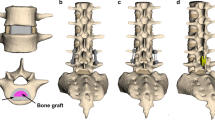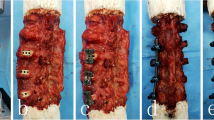Abstract
Little biomechanical data has been gathered for the biomechanical effects of pedicle-based dynamic stabilization system (PBDS) and fusion (a conventional titanium rod and cage) to the whole lumbar spine according to the instrumentation level. A previously validated three-dimensional, intact osteoligamentous L1-S1 finite element model was modified to incorporate three different PBDS (Dynesys, Nflex, or PEEK) and fusion at three different levels (L3-L4, L4-L5, and L5-S1). A new loading method that can create the segmental motion similar to an in-vivo measurement was applied to the model. The biomechanical changes in the stabilized models were compared with those of the intact model during sagittal plane motion. The simulation results demonstrated that Dynesys generated relatively larger motion when it was instrumented at the L3-L4 segment, whereas the Nflex was the most appropriate device for L4-L5 stabilization. Depending on the stabilization device and instrumented level, whole-lumbar segmental motion also varied. During flexion, stabilization at the L3-L4 level or L4-L5 level produced a relatively higher increase in the motion at all cranial levels. Stabilization at the L5-S1 level generated a slight decrease in the motion at the adjacent cranial level without respect to the type of fixation. In cases of fusion, the change in the motion was higher relative to that with PBDS. Given the biomechanical change at each level after stabilization, adjacent segment degeneration was expected cranially rather caudally, and the probability of this degeneration differed depending on the stabilization level and device.
Similar content being viewed by others
References
Cunningham, B. W., “Basic Scientific Considerations in Total Disc Arthroplasty,” The Spine Journal, Vol. 4, No. 6, pp. S219–S230, 2004.
Lee, C. K., “Accelerated Degeneration of the Segment Adjacent to a Lumbar Fusion,” Spine, Vol. 13, No. 3, pp. 375–377, 1988.
Bono, C. M., Kadaba, M., and Vaccaro, A. R., “Posterior Pedicle Fixation-based Dynamic Stabilization Devices for the Treatment of Degenerative Diseases of the Lumbar Spine,” Journal of Spinal Disorders & Techniques, Vol. 22, No. 5, pp. 376–383, 2009.
Meyers, K., Tauber, M., Sudin, Y., Fleischer, S., Arnin, U., et al., “Use of Instrumented Pedicle Screws to Evaluate Load Sharing in Posterior Dynamic Stabilization Systems,” The Spine Journal, Vol. 8, No. 6, pp. 926–932, 2008.
Sengupta, D. K., “Dynamic Stabilization Devices in the Treatment of Low Back Pain,” Orthopedic Clinics, Vol. 35, No. 1, pp. 43–56, 2004.
Mulholland, R. C. and Sengupta, D. K., “Rationale, Principles and Experimental Evaluation of the Concept of Soft Stabilization,” European Spine Journal, Vol. 11, No. 2, pp. S198–S205, 2002.
Kaner, T., Dalbayrak, S., Oktenoglu, T., Sasani, M., Aydin, A. L., and Ozer, A. F., “Comparison of Posterior Dynamic and Posterior Rigid Transpedicular Stabilization with Fusion to Treat Degenerative Spondylolisthesis,” Orthopedics, Vol. 33, No. 5, pp. 309–309, 2010.
Schaeren, S., Broger, I., and Jeanneret, B., “Minimum Four-Year Follow-Up of Spinal Stenosis with Degenerative Spondylolisthesis Treated with Decompression and Dynamic Stabilization,” Spine, Vol. 33, No. 18, pp. E636–E642, 2008.
Highsmith, J. M., Tumialán, L. M., and Rodts Jr, G. E., “Flexible Rods and the Case for Dynamic Stabilization,” Neurosurgical Focus, Vol. 22, No. 1, pp. 1–5, 2007.
Cheng, B. C., Gordon, J., Cheng, J., and Welch, W. C., “Immediate Biomechanical Effects of Lumbar Posterior Dynamic Stabilization above a Circumferential Fusion,” Spine, Vol. 32, No. 23, pp. 2551–2557, 2007.
Putzier, M., Hoff, E., Tohtz, S., Gross, C., Perka, C., and Strube, P., “Dynamic Stabilization Adjacent to Single-Level Fusion: Part II. No Clinical Benefit for Asymptomatic, Initially Degenerated Adjacent Segments after 6 Years Follow-Up,” European Spine Journal, Vol. 19, No. 12, pp. 2181–2189, 2010.
Strube, P., Tohtz, S., Hoff, E., Gross, C., Perka, C., and Putzier, M., “Dynamic Stabilization Adjacent to Single-Level Fusion: Part I. Biomechanical Effects on Lumbar Spinal Motion,” European Spine Journal, Vol. 19, No. 12, pp. 2171–2180, 2010.
Kim, Y. E. and Choi, H. W., “Effect of Disc Degeneration on the Muscle Recruitment Pattern in Upright Posture: a Computational Analysis,” Computer Methods in Biomechanics and Biomedical Engineering, Vol. 18, No. 15, pp. 1622–1631, 2015.
Scapinelli, R., Stecco, C., Pozzuoli, A., Porzionato, A., Macchi, V., and De Caro, R., “The Lumbar Interspinous Ligaments in Humans: Anatomical Study and Review of the Literature,” Cells Tissues Organs, Vol. 183, No. 1, pp. 1–11, 2006.
Schmidt, H., Heuer, F., Simon, U., Kettler, A., Rohlmann, A.,et al., “Application of a New Calibration Method for a Three-Dimensional Finite Element Model of a Human Lumbar Annulus Fibrosus,” Clinical Biomechanics, Vol. 21, No. 4, pp. 337–344, 2006.
Panjabi, M. M., Oxland, T. R., Yamamoto, I., and Crisco, J. J., “Mechanical Behavior of the Human Lumbar and Lumbosacral Spine as Shown by Three-Dimensional Load-Displacement Curves,” The Journal of Bone & Joint Surgery, Vol. 76, No. 3, pp. 413–424, 1994.
Guan, Y., Yoganandan, N., Moore, J., Pintar, F. A., Zhang, J., et al., “Moment-Rotation Responses of the Human Lumbosacral Spinal Column,” Journal of Biomechanics, Vol. 40, No. 9, pp. 1975–1980, 2007.
Schendel, M. J., Wood, K. B., Buttermann, G. R., Lewis, J. J., and Ogilvie, J. W., “Experimental Measurement of Ligament Force, Facet Force, and Segment Motion in the Human Lumbar Spine,” Journal of Biomechanics, Vol. 26, No. 4–5, pp. 427–438, 1993.
Schultz, A. B., Warwick, D. N., Berkson, M. H., and Nachemson, A. L., “Mechanical Properties of Human Lumbar Spine Motion Segments-Part I: Responses in Flexion, Extension, Lateral Bending, and Torsion,” Journal of Biomechanical Engineering, Vol. 101, No. 1, pp. 46–52, 1979.
Andersson, G. B. and Schultz, A. B., “Effects of Fluid Injection on Mechanical Properties of Intervertebral Discs,” Journal of Biomechanics, Vol. 12, No. 6, pp. 453–458, 1979.
Panjabi, M. M., Goel, V. K., and Takata, K., “Physiologic Strains in the Lumbar Spinal Ligaments. An in vitro Biomechanical Study 1981 volvo Award in Biomechanics,” Spine, Vol. 7, No. 3, pp. 192–203, 1982.
Wong, K. W. N., Luk, K. D., Leong, J. C., Wong, S. F., and Wong, K. K., “Continuous Dynamic Spinal Motion Analysis,” Spine, Vol. 31, No. 4, pp. 414–419, 2006.
Granata, K. P. and Sanford, A. H., “Lumbar-Pelvic Coordination is Influenced by Lifting Task Parameters,” Spine, Vol. 25, No. 11, pp. 1413–1418, 2000.
Dreischarf, M., Zander, T., Bergmann, G., and Rohlmann, A., “A Non-Optimized Follower Load Path May Cause Considerable Intervertebral Rotations,” Journal of Biomechanics, Vol. 43, No. 13, pp. 2625–2628, 2010.
Wilke, H.-J., Neef, P., Hinz, B., Seidel, H., and Claes, L., “Intradiscal Pressure Together with Anthropometric Data-A Data Set for the Validation of Models,” Clinical Biomechanics, Vol. 16, Suppl. 1, pp. S111–S126, 2001.
Jahng, T.-A., Kim, Y. E., and Moon, K. Y., “Comparison of the Biomechanical Effect of Pedicle-based Dynamic Stabilization: A Study using Finite Element Analysis,” The Spine Journal, Vol. 13, No. 1, pp. 85–94, 2013.
van den Bos, W., van Duersen, D. L., and Kingma, I., “Non-Linear Behavior of the Intervertebral Disc, a Finite Element Approach,” Proc. of the IASTED International Conference on Applied Simulation and Modelling, 2002.
Panjabi, M. M., “Hybrid Multidirectional Test Method to Evaluate Spinal Adjacent-Level Effects,” Clinical Biomechanics, Vol. 22, No. 3, pp. 257–265, 2007.
Wilke, H.-J., Heuer, F., and Schmidt, H., “Prospective Design Delineation and Subsequent in vitro Evaluation of a New Posterior Dynamic Stabilization System,” Spine, Vol. 34, No. 3, pp. 255–261, 2009.
Moumene, M. and Harms, J., “Is Posterior Dynamic Stabilization an Option to Avoid Adjacent Segment Decompensation?” in: Surgery for Low Back Pain, Szpalski, M., Gunzburg, R., Rydevik, B. L., Le Huec, J., Mayer, H. M., (Eds.), Springer, pp. 207–211, 2010.
Harada, M., Abumi, K., Ito, M., and Kaneda, K., “Cineradiographic Motion Analysis of Normal Lumbar Spine during Forward and Backward Flexion,” Spine, Vol. 25, No. 15, pp. 1932–1937, 2000.
Lee, C. S., Hwang, C. J., Lee, S.-W., Ahn, Y.-J., Kim, Y.-T., et al., “Risk Factors for Adjacent Segment Disease after Lumbar Fusion,” European Spine Journal, Vol. 18, No. 11, pp. 1637–1643, 2009.
Park, P., Garton, H. J., Gala, V. C., Hoff, J. T., and McGillicuddy, J. E., “Adjacent Segment Disease after Lumbar or Lumbosacral Fusion: Review of the Literature,” Spine, Vol. 29, No. 17, pp. 1938–1944, 2004.
Ghiselli, G., Wang, J. C., Hsu, W. K., and Dawson, E. G., “L5-S1 Segment Survivorship and Clinical Outcome Analysis after L4-L5 Isolated Fusion,” Spine, Vol. 28, No. 12, pp. 1275–1280, 2003.
Schmoelz, W., Huber, J. F., Nydegger, T., Claes, L., and Wilke, H. J., “Dynamic Stabilization of the Lumbar Spine and Its Effects on Adjacent Segments: An in vitro Experiment,” Journal of Spinal Disorders & Techniques, Vol. 16, No. 4, pp. 418–423, 2003.
Rohlmann, A., Neller, S., Bergmann, G., Graichen, F., Claes, L., and Wilke, H.-J., “Effect of an Internal Fixator and a Bone Graft on Intersegmental Spinal Motion and Intradiscal Pressure in the Adjacent Regions,” European Spine Journal, Vol. 10, No. 4, pp. 301–308, 2001.
Cegoñino, J., Calvo-Echenique, A., and Pérezdel Palomar, A., “Influence of Different Fusion Techniques in Lumbar Spine Over the Adjacent Segments: A 3D Finite Element Study,” Journal of Orthopaedic Research, Vol. 33, No. 7, pp. 993–1000, 2015.
Erbulut, D. U., Kiapour, A., Oktenoglu, T., Ozer, A. F., and Goel, V. K., “A Computational Biomechanical Investigation of Posterior Dynamic Instrumentation: Combination of Dynamic Rod and Hinged (Dynamic) Screw,” Journal of Biomechanical Engineering, Vol. 136, No. 5, Paper No. 051007, 2014.
Lee, S.-H., Daffner, S. D., Wang, J. C., Davis, B. C., Alanay, A., and Kim, J. S., “The Change of Whole Lumbar Segmental Motion according to the Mobility of Degenerated Disc in the Lower Lumbar Spine: A Kinetic MRI Study,” European Spine Journal, Vol. 24, No. 9, pp. 1893–1900, 2015.
Author information
Authors and Affiliations
Corresponding author
Rights and permissions
About this article
Cite this article
Choi, H.W., Kim, Y.E. & Chae, SW. Effects of the level of mono-segmental dynamic stabilization on the whole lumbar spine. Int. J. Precis. Eng. Manuf. 17, 603–611 (2016). https://doi.org/10.1007/s12541-016-0073-1
Received:
Revised:
Accepted:
Published:
Issue Date:
DOI: https://doi.org/10.1007/s12541-016-0073-1




